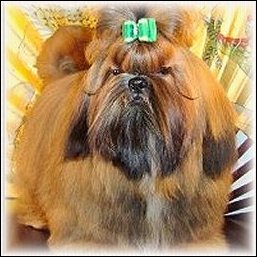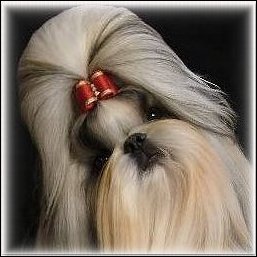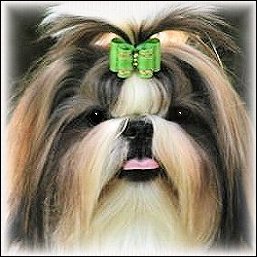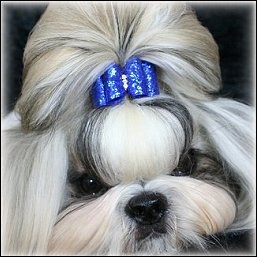Have you ever thought about using
color theory to choose the best color show dog bow for
your show dog? A little knowledge of color theory
will help you to understand what makes a bow color “pop”
on your dog, and will help you achieve the effect that
you desire. Maybe your show dog has some facial
staining that you want to detract from. You can do this
with color. What kind of effect do you want the bow to
have? Do you want the dog bow color to compliment the
coat color and make it appear more intense? You can also
do this with color. Maybe you want to emphasize contrast
but stay harmonious with your dogs coloring. Anyone can
use principles in color theory. Make choices in
color that will benefit and compliment your dog and meet
your goals for presentation.
Contrast: Contrast is
the difference between two colors. The greater
the distance between two colors on the color wheel, the
greater the contrast, and the way that colors relate to
one another is related to their position on the color
wheel. Contrast varies with differences in hue, value,
and saturation In addition, effects/contrast is
further enhanced or subdued by introducing tints (add
white) or shades (add black or compliment color) to the
mix of colors. Contrast also has to do with what
we call warm colors and cool colors; contrast of hue
creates warm or cool colors. For example: Red is a warm
color…add white to make it a tint and you get pink which
is a cool color and a lighter hue of red (a tint).
Facial stains are warm colors and can be tempered by
using cool colors for dog bows.
Decide what your goal is for
the final effect when choosing your show bow colors.
When choosing your dog bow color always take
into consideration the color of the dog’s coat as the
starting point color and choose the dog bow color to either
enhance the coat, be harmonious with the coat, or for
highlight and to add dramatic effect. What does
all this mean to you? The color of your dog’s coat
is the most important consideration when choosing a
color. You can adjust the effect that a
color has by either choosing a compliment color, a
split-compliment color, an analog color, and by varying
the color with tints and shades of the same color.
Choosing Complementary Colors
will feel vibrant and complement the coat color
with contrast. On a color wheel,
Complementary colors are directly opposite each other.
- Orange-Red-Gold Coat: Ultra Blue,
Royal Blue, Kelly Green, Tints of Green dog bows.
- Mahogany Red Coat: Emerald
Green, Forest or Hunter Green dog bows.
- Gold Coat: BOB Purple
dog bows.




Choosing Split Complementary Colors
will give a high degree of contrast with greater
harmony than complementary colors. On a color
wheel, Split Complementary colors are the
complements “next door neighbor”.
- Orange-Red Coat: Teal Blue,
Baby Blue, Turquoise, Periwinkle dog bows.
- Mahogany Red Coat: Teal Blue,
Aqua Blue, Green Blues dog bows.
- Gold Coat: Hot Pink and Pinks, Fuchsia,
Raspberry, Royal Blue, Royal Purple, Periwinkle,
Turquoise dog bows.




Choosing Analog Colors will
feel harmonious with the coat color. On a color
wheel, analog colors lie on either side of any given
color. Analog colors are combinations often found in
nature.
- Orange-Red Coat: Ginger,
Apricot, Reds, Rust dog bows.
- Mahogany Red Coat: Burgundy,
Cranberry Red, Rust, Hot Pink, Pinks dog bows.
- Gold with Black Eye stripes
and Silver Coats: Blacks, Old Gold, Sable, Cranberry Red
dog bows.




For highlight and dramatic
effect on Monotone Cromatic Colors (neutral coat
colors) ranging from black to white (Includes silver and
grey) use one bright color. For this color
scheme you will consider the coat color to be Monotone
Cromatic and choose the bright bow color to create
highlight and drama. Choosing dog bow colors of various
tints and shades of these colors will subdue the effect.
Adding white to a color reduces brightness and
vibrancy. Also, the use of a pure white or a pure black
with these neutral colors would also be effective but
avoid a monochromatic color scheme. (Same color as coat)
- Black or Black and White
Coat: True Red, Royal Blue, Purple, Yellow,
Orange dog bows.
- Silver Coat:
True Red, Royal Blue, Purple, Bright Pink, Emerald
Green, and all tints and shades of these colors dog
bows.
- Brindle Coat: True Red, Royal
Blue, Purples, Bright Pinks, Lime Green, and all
tints and shades of these colors dog bows.




More articles by Doggie Bow
Ties...
Comments? Email me!
Check out my dog bows! HERE
-->Home
Page

No permission will be given to copy, reproduce,
republish, upload, post,
transmit, or distribute
this article or photos displayed. |

